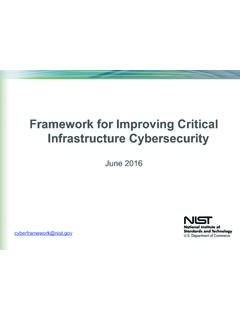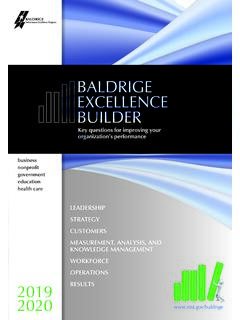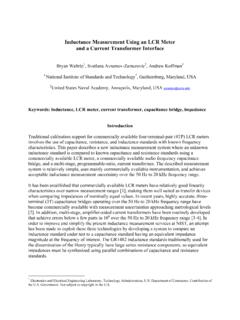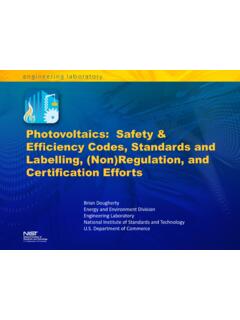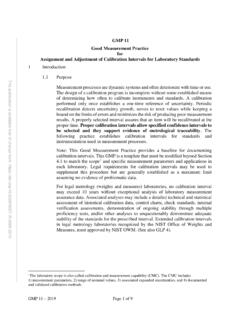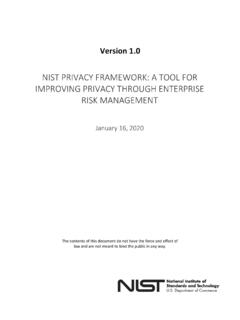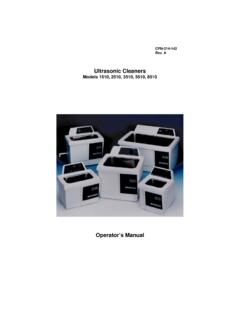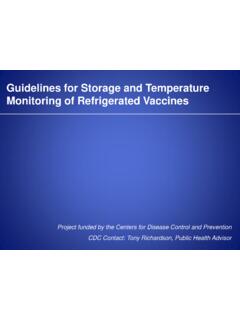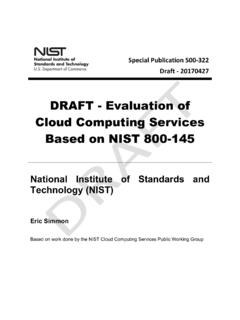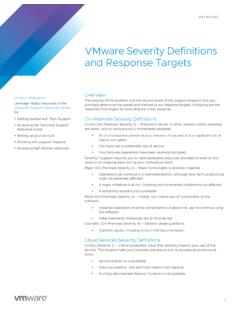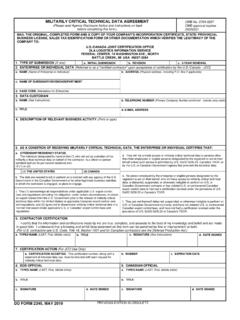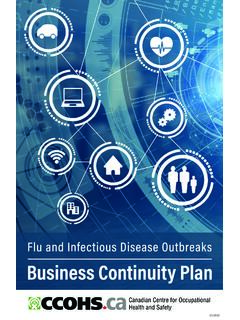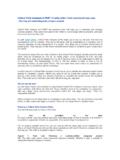Transcription of Framework for Improving Critical Infrastructure …
1 Framework for Improving Critical Infrastructure Cybersecurity Version National Institute of Standards and Technology February 12, 2014 February 12, 2014 Cybersecurity Framework Version ii Table of Contents Executive Summary ..1 Framework Introduction ..3 Framework Basics ..7 How to Use the Framework ..13 Appendix A: Framework Core ..18 Appendix B: Glossary ..37 Appendix C: Acronyms ..39 List of Figures Figure 1: Framework Core Structure .. 7 Figure 2: Notional Information and Decision Flows within an Organization .. 12 List of Tables Table 1: Function and Category Unique Identifiers .. 19 Table 2: Framework Core .. 20 February 12, 2014 Cybersecurity Framework Version 1 E xe c u t i v e S u m m a r y The national and economic security of the United States depends on the reliable functioning of Critical Infrastructure .
2 Cybersecurity threats exploit the increased complexity and connectivity of Critical Infrastructure systems, placing the Nation s security, economy, and public safety and health at risk. Similar to financial and reputational risk, cybersecurity risk affects a company s bottom line. It can drive up costs and impact revenue. It can harm an organization s ability to innovate and to gain and maintain customers. To better address these risks, the President issued Executive Order 13636, Improving Critical Infrastructure Cybersecurity, on February 12, 2013, which established that [i]t is the Policy of the United States to enhance the security and resilience of the Nation s Critical Infrastructure and to maintain a cyber environment that encourages efficiency, innovation, and economic prosperity while promoting safety, security, business confidentiality, privacy, and civil liberties.
3 In enacting this policy, the Executive Order calls for the development of a voluntary risk-based Cybersecurity Framework a set of industry standards and best practices to help organizations manage cybersecurity risks. The resulting Framework , created through collaboration between government and the private sector, uses a common language to address and manage cybersecurity risk in a cost-effective way based on business needs without placing additional regulatory requirements on businesses. The Framework focuses on using business drivers to guide cybersecurity activities and considering cybersecurity risks as part of the organization s risk management processes. The Framework consists of three parts: the Framework Core, the Framework Profile, and the Framework Implementation Tiers. The Framework Core is a set of cybersecurity activities, outcomes, and informative references that are common across Critical Infrastructure sectors, providing the detailed guidance for developing individual organizational Profiles.
4 Through use of the Profiles, the Framework will help the organization align its cybersecurity activities with its business requirements, risk tolerances, and resources. The Tiers provide a mechanism for organizations to view and understand the characteristics of their approach to managing cybersecurity risk. The Executive Order also requires that the Framework include a methodology to protect individual privacy and civil liberties when Critical Infrastructure organizations conduct cybersecurity activities. While processes and existing needs will differ, the Framework can assist organizations in incorporating privacy and civil liberties as part of a comprehensive cybersecurity program. The Framework enables organizations regardless of size, degree of cybersecurity risk, or cybersecurity sophistication to apply the principles and best practices of risk management to Improving the security and resilience of Critical Infrastructure .
5 The Framework provides organization and structure to today s multiple approaches to cybersecurity by assembling standards, guidelines, and practices that are working effectively in industry today. Moreover, because it references globally recognized standards for cybersecurity, the Framework can also be February 12, 2014 Cybersecurity Framework Version 2 used by organizations located outside the United States and can serve as a model for international cooperation on strengthening Critical Infrastructure cybersecurity. The Framework is not a one-size-fits-all approach to managing cybersecurity risk for Critical Infrastructure . Organizations will continue to have unique risks different threats, different vulnerabilities, different risk tolerances and how they implement the practices in the Framework will vary.
6 Organizations can determine activities that are important to Critical service delivery and can prioritize investments to maximize the impact of each dollar spent. Ultimately, the Framework is aimed at reducing and better managing cybersecurity risks. The Framework is a living document and will continue to be updated and improved as industry provides feedback on implementation. As the Framework is put into practice, lessons learned will be integrated into future versions. This will ensure it is meeting the needs of Critical Infrastructure owners and operators in a dynamic and challenging environment of new threats, risks, and solutions. Use of this voluntary Framework is the next step to improve the cybersecurity of our Nation s Critical Infrastructure providing guidance for individual organizations, while increasing the cybersecurity posture of the Nation s Critical Infrastructure as a whole.
7 February 12, 2014 Cybersecurity Framework Version 3 1. 0 Fr a m e wo r k I n t r o d u c t i o n The national and economic security of the United States depends on the reliable functioning of Critical Infrastructure . To strengthen the resilience of this Infrastructure , President Obama issued Executive Order 13636 (EO), Improving Critical Infrastructure Cybersecurity, on February 12, This Executive Order calls for the development of a voluntary Cybersecurity Framework ( Framework ) that provides a prioritized, flexible, repeatable, performance-based, and cost-effective approach to manage cybersecurity risk for those processes, information, and systems directly involved in the delivery of Critical Infrastructure services. The Framework , developed in collaboration with industry, provides guidance to an organization on managing cybersecurity risk.
8 Critical Infrastructure is defined in the EO as systems and assets, whether physical or virtual, so vital to the United States that the incapacity or destruction of such systems and assets would have a debilitating impact on security, national economic security, national public health or safety, or any combination of those matters. Due to the increasing pressures from external and internal threats, organizations responsible for Critical Infrastructure need to have a consistent and iterative approach to identifying, assessing, and managing cybersecurity risk. This approach is necessary regardless of an organization s size, threat exposure, or cybersecurity sophistication today. The Critical Infrastructure community includes public and private owners and operators, and other entities with a role in securing the Nation s Infrastructure .
9 Members of each Critical Infrastructure sector perform functions that are supported by information technology (IT) and industrial control systems (ICS).2 This reliance on technology, communication, and the interconnectivity of IT and ICS has changed and expanded the potential vulnerabilities and increased potential risk to operations. For example, as ICS and the data produced in ICS operations are increasingly used to deliver Critical services and support business decisions, the potential impacts of a cybersecurity incident on an organization s business , assets, health and safety of individuals, and the environment should be considered. To manage cybersecurity risks, a clear understanding of the organization s business drivers and security considerations specific to its use of IT and ICS is required.
10 Because each organization s risk is unique, along with its use of IT and ICS, the tools and methods used to achieve the outcomes described by the Framework will vary. Recognizing the role that the protection of privacy and civil liberties plays in creating greater public trust, the Executive Order requires that the Framework include a methodology to protect individual privacy and civil liberties when Critical Infrastructure organizations conduct cybersecurity activities. Many organizations already have processes for addressing privacy and civil liberties. The methodology is designed to complement such processes and provide guidance to facilitate privacy risk management consistent with an organization s approach to cybersecurity risk management. Integrating privacy and cybersecurity can benefit organizations by increasing customer confidence, enabling more standardized sharing of information, and simplifying operations across legal regimes.
